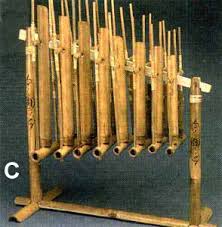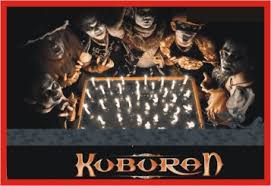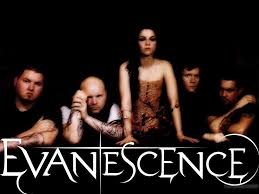
Angklung adalah alat musik tradisional Indonesia yang berasal dar Tanah Sunda, terbuat dari bambu, yang dibunyikan dengan cara digoyangkan (bunyi disebabkan oleh benturan badan pipa bambu) sehingga menghasilkan bunyi yang bergetar dalam susunan nada 2, 3, sampai 4 nada dalam setiap ukuran, baik besar maupun kecil. Laras (nada) alat musik angklung sebagai musik tradisi Sunda kebanyakan adalah salendro dan pelog.
Asal MuasaL Angklung

Dalam rumpun kesenian yang menggunakan alat musik dari bambu dikenal jenis kesenian yang disebut angklung. Adapun jenis bambu yang biasa digunakan sebagai alat musik tersebut adalah awi wulung (bambu berwarna hitam) dan awi temen (bambu berwarna putih). Purwa rupa alat musik angklung; tiap nada (laras) dihasilkan dari bunyi tabung bambunya yang berbentuk wilahan (batangan) setiap ruas bambu dari ukuran kecil hingga besar.
Angklung merupakan alat musik yang berasal dari Jawa Barat. Angklung gubrag di Jasinga, Bogor, adalah salah satu yang masih hidup sejak lebih dari 400 tahun lampau. Kemunculannya berawal dari ritus padi. Angklung diciptakan dan dimainkan untuk memikat Dewi Sri turun ke Bumi agar tanaman padi rakyat tumbuh subur.
Dikenal oleh masyarakat sunda sejak masa kerajaan Sunda, di antaranya sebagai penggugah semangat dalam pertempuran. Fungsi angklung sebagai pemompa semangat rakyat masih terus terasa sampai pada masa penjajahan, itu sebabnya pemerintah Hindia Belanda sempat melarang masyarakat menggunakan angklung, pelarangan itu sempat membuat popularitas angklung menurun dan hanya di mainkan oleh anak- anak pada waktu itu.
Asal usul terciptanya musik bambu, seperti angklung berdasarkan pandangan hidup masyarakat Sunda yang agraris dengan sumber kehidupan dari padi (pare) sebagai makanan pokoknya. Hal ini melahirkan mitos kepercayaan terhadap Nyai Sri Pohaci sebagai lambang Dewi Padi pemberi kehidupan (hirup-hurip).
Perenungan masyarakat Sunda dahulu dalam mengolah pertanian (tatanen) terutama di sawah dan huma telah melahirkan penciptaan syair dan lagu sebagai penghormatan dan persembahan terhadap Nyai Sri Pohaci, serta upaya nyinglar (tolak bala) agar cocok tanam mereka tidak mengundang malapetaka, baik gangguan hama maupun bencana alam lainnya. Syair lagu buhun untuk menghormati Nyi Sri Pohaci tersebut misalnya:
Si Oyong-oyong
Sawahe si waru doyong
Sawahe ujuring eler
Sawahe ujuring etan
Solasi suling dami
Menyan putih pengundang dewa
Dewa-dewa widadari
Panurunan si patang puluh
Selanjutnya lagu-lagu persembahan terhadap Dewi Sri tersebut disertai dengan pengiring bunyi tabuh yang terbuat dari batang-batang bambu yang dikemas sederhana yang kemudian lahirlah struktur alat musik bambu yang kita kenal sekarang bernama angklung. Perkembangan selanjutnya dalam permainan Angklung tradisi disertai pula dengan unsur gerak dan ibing (tari) yang ritmis (ber-wirahma) dengan pola dan aturan=aturan tertentu sesuai dengan kebutuhan upacara penghormatan padi pada waktu mengarak padi ke lumbung (ngampih pare, nginebkeun), juga pada saat-saat mitembeyan, mengawali menanam padi yang di sebagian tempat di Jawa Barat disebut ngaseuk.

Demikian pula pada saat pesta panen dan seren taun dipersembahkan permainan angklung. Terutama pada penyajian Angklung yang berkaitan dengan upacara padi, kesenian ini menjadi sebuah pertunjukan yang sifatnya arak-arakan atau helaran, bahkan di sebagian tempat menjadi iring-iringan Rengkong dan Dongdang serta Jampana (usungan pangan) dan sebagainya.
Dalam perkembangannya, angklung berkembang dan menyebar ke seantero Jawa, lalu ke Kalimantan dan Sumatera. Pada 1908 tercatat sebuah misi kebudayaan dari Indonesia ke Thailand, antara lain ditandai penyerahan angklung, lalu permainan musik bambu ini pun sempat menyebar di sana.
Bahkan, sejak 1966, Udjo Ngalagena —tokoh angklung yang mengembangkan teknik permainan berdasarkan laras-laras pelog, salendro, dan madenda— mulai mengajarkan bagaimana bermain angklung kepada banyak orang dari berbagai komunitas.
Angklung KANEKES
Angklung di daerah Kanekes (kita sering menyebut mereka orang Baduy) digunakan terutama karena hubungannya dengan ritus padi, bukan semata-mata untuk hiburan orang-orang. Angklung digunakan atau dibunyikan ketika mereka menanam padi di huma (ladang). Menabuh angklung ketika menanam padi ada yang hanya dibunyikan bebas (dikurulungkeun), terutama di Kajeroan (Tangtu; Baduy Jero), dan ada yang dengan ritmis tertentu, yaitu di Kaluaran (Baduy Luar). Meski demikian, masih bisa ditampilkan di luar ritus padi tetapi tetap mempunyai aturan, misalnya hanya boleh ditabuh hingga masa ngubaran pare (mengobati padi), sekitar tiga bulan dari sejak ditanamnya padi. Setelah itu, selama enam bulan berikutnya semua kesenian tidak boleh dimainkan, dan boleh dimainkan lagi pada musim menanam padi berikutnya. Menutup angklung dilaksanakan dengan acara yang disebut musungkeun angklung, yaitu nitipkeun (menitipkan, menyimpan) angklung setelah dipakai.
Dalam sajian hiburan, Angklung biasanya diadakan saat terang bulan dan tidak hujan. Mereka memainkan angklung di buruan (halaman luas di pedesaan) sambil menyanyikan bermacam-macam lagu, antara lain: Lutung Kasarung, Yandu Bibi, Yandu Sala, Ceuk Arileu, Oray-orayan, Dengdang, Yari Gandang, Oyong-oyong Bangkong, Badan Kula, Kokoloyoran, Ayun-ayunan, Pileuleuyan, Gandrung Manggu, Rujak Gadung, Mulung Muncang, Giler, Ngaranggeong, Aceukna, Marengo, Salak Sadapur, Rangda Ngendong, Celementre, Keupat Reundang, Papacangan, dan Culadi Dengdang. Para penabuh angklung sebanyak delapan orang dan tiga penabuh bedug ukuran kecil membuat posisi berdiri sambil berjalan dalam formasi lingkaran. Sementara itu yang lainnya ada yang ngalage (menari) dengan gerakan tertentu yang telah baku tetapi sederhana. Semuanya dilakukan hanya oleh laki-laki. Hal ini berbeda dengan masyarakat Daduy Dalam, mereka dibatasi oleh adat dengan berbagai aturan pamali (pantangan; tabu), tidak boleh melakukan hal-hal kesenangan duniawi yang berlebihan. Kesenian semata-mata dilakukan untuk keperluan ritual.
Nama-nama angklung di Kanekes dari yang terbesar adalah: indung, ringkung, dongdong, gunjing, engklok, indung leutik, torolok, dan roel. Roel yang terdiri dari 2 buah angklung dipegang oleh seorang. Nama-nama bedug dari yang terpanjang adalah: bedug, talingtit, dan ketuk. Penggunaan instrumen bedug terdapat perbedaan, yaitu di kampung-kampung Kaluaran mereka memakai bedug sebanyak 3 buah. Di Kajeroan; kampung Cikeusik, hanya menggunakan bedug dan talingtit, tanpa ketuk. Di Kajeroan, kampung Cibeo, hanya menggunakan bedug, tanpa talingtit dan ketuk.
Di Kanekes yang berhak membuat angklung adalah orang Kajeroan (Tangtu; Baduy Jero). Kajeroan terdiri dari 3 kampung, yaitu Cibeo, Cikartawana, dan Cikeusik. Di ketiga kampung ini tidak semua orang bisa membuatnya, hanya yang punya keturunan dan berhak saja yang mengerjakannya di samping adanya syarat-syarat ritual. Pembuat angklung di Cikeusik yang terkenal adalah Ayah Amir (59), dan di Cikartawana Ayah Tarnah. Orang Kaluaran membeli dari orang Kajeroan di tiga kampung tersebut.
Angklung Dogdog Lojor
Kesenian dogdog lojor terdapat di masyarakat Kasepuhan Pancer Pangawinan atau kesatuan adat Banten Kidul yang tersebar di sekitar Gunung Halimun (berbatasan dengan Sukabumi, Bogor, dan Lebak). Meski kesenian ini dinamakan dogdog lojor, yaitu nama salah satu instrumen di dalamnya, tetapi di sana juga digunakan angklung karena kaitannya dengan acara ritual padi. Setahun sekali, setelah panen seluruh masyarakat mengadakan acara Serah Taun atau Seren Taun di pusat kampung adat. Pusat kampung adat sebagai tempat kediaman kokolot (sesepuh) tempatnya selalu berpindah-pindah sesuai petunjuk gaib.
Tradisi penghormatan padi pada masyarakat ini masih dilaksanakan karena mereka termasuk masyarakat yang masih memegang teguh adat lama. Secara tradisi mereka mengaku sebagai keturunan para pejabat dan prajurit keraton Pajajaran dalam baresan Pangawinan (prajurit bertombak). Masyarakat Kasepuhan ini telah menganut agama Islam dan agak terbuka akan pengaruh modernisasi, serta hal-hal hiburan kesenangan duniawi bisa dinikmatinya. Sikap ini berpengaruh pula dalam dalam hal fungsi kesenian yang sejak sekitar tahun 1970-an, dogdog lojor telah mengalami perkembangan, yaitu digunakan untuk memeriahkan khitanan anak, perkawinan, dan acara kemeriahan lainnya. Instrumen yang digunakan dalam kesenian dogdog lojor adalah 2 buah dogdog lojor dan 4 buah angklung besar. Keempat buah angklung ini mempunyai nama, yang terbesar dinamakan gonggong, kemudian panembal, kingking, dan inclok. Tiap instrumen dimainkan oleh seorang, sehingga semuanya berjumlah enam orang.
Lagu-lagu dogdog lojor di antaranya Bale Agung, Samping Hideung, Oleng-oleng Papanganten, Si Tunggul Kawung, Adulilang, dan Adu-aduan. Lagu-lagu ini berupa vokal dengan ritmis dogdog dan angklung cenderung tetap.
Angklung Gubrag
Angklung gubrag terdapat di kampung Cipining, kecamatan Cigudeg, Bogor. Angklung ini telah berusia tua dan digunakan untuk menghormati dewi padi dalam kegiatan melak pare (menanam padi), ngunjal pare (mengangkut padi), dan ngadiukeun (menempatkan) ke leuit (lumbung).
Dalam mitosnya angklung gubrag mulai ada ketika suatu masa kampung Cipining mengalami musim paceklik.
Angklung Badeng
Badeng merupakan jenis kesenian yang menekankan segi musikal dengan angklung sebagai alat musiknya yang utama. Badeng terdapat di Desa Sanding, Kecamatan Malangbong, Garut. Dulu berfungsi sebagai hiburan untuk kepentingan dakwah Islam. Tetapi diduga badeng telah digunakan masyarakat sejak lama dari masa sebelum Islam untuk acara-acara yang berhubungan dengan ritual penanaman padi. Sebagai seni untuk dakwah badeng dipercaya berkembang sejak Islam menyebar di daerah ini sekitar abad ke-16 atau 17. Pada masa itu penduduk Sanding, Arpaen dan Nursaen, belajar agama Islam ke kerajaan Demak. Setelah pulang dari Demak mereka berdakwah menyebarkan agama Islam. Salah satu sarana penyebaran Islam yang digunakannya adalah dengan kesenian badeng.
Angklung yang digunakan sebanyak sembilan buah, yaitu 2 angklung roel, 1 angklung kecer, 4 angklung indung dan angklung bapa, 2 angklung anak; 2 buah dogdog, 2 buah terbang atau gembyung, serta 1 kecrek. Teksnya menggunakan bahasa Sunda yang bercampur dengan bahasa Arab. Dalam perkembangannya sekarang digunakan pula bahasa Indonesia. Isi teks memuat nilai-nilai Islami dan nasihat-nasihat baik, serta menurut keperluan acara. Dalam pertunjukannya selain menyajikan lagu-lagu, disajikan pula atraksi kesaktian, seperti mengiris tubuh dengan senjata tajam.
Buncis
Buncis merupakan seni pertunjukan yang bersifat hiburan, di antaranya terdapat di Baros (Arjasari, Bandung). Pada mulanya buncis digunakan pada acara-acara pertanian yang berhubungan dengan padi. Tetapi pada masa sekarang buncis digunakan sebagai seni hiburan. Hal ini berhubungan dengan semakin berubahnya pandangan masyarakat yang mulai kurang mengindahkan hal-hal berbau kepercayaan lama. Tahun 1940-an dapat dianggap sebagai berakhirnya fungsi ritual buncis dalam penghormatan padi, karena sejak itu buncis berubah menjadi pertunjukan hiburan. Sejalan dengan itu tempat-tempat penyimpanan padi pun (leuit; lumbung) mulai menghilang dari rumah-rumah penduduk, diganti dengan tempat-tempat karung yang lebih praktis, dan mudah dibawa ke mana-mana. Padi pun sekarang banyak yang langsung dijual, tidak disimpan di lumbung. Dengan demikian kesenian buncis yang tadinya digunakan untuk acara-acara ngunjal (membawa padi) tidak diperlukan lagi.
Nama kesenian buncis berkaitan dengan sebuah teks lagu yang terkenal di kalangan rakyat, yaitu cis kacang buncis nyengcle..., dst. Teks tersebut terdapat dalam kesenian buncis, sehingga kesenian ini dinamakan buncis.
Instrumen yang digunakan dalam kesenian buncis adalah 2 angklung indung, 2 angklung ambrug, angklung panempas, 2 angklung pancer, 1 angklung enclok. Kemudian 3 buah dogdog, terdiri dari 1 talingtit, panembal, dan badublag. Dalam perkembangannya kemudian ditambah dengan tarompet, kecrek, dan goong. Angklung buncis berlaras salendro dengan lagu vokal bisa berlaras madenda atau degung. Lagu-lagu buncis di antaranya: Badud, Buncis, Renggong, Senggot, Jalantir, Jangjalik, Ela-ela, Mega Beureum. Sekarang lagu-lagu buncis telah menggunakan pula lagu-lagu dari gamelan, dengan penyanyi yang tadinya laki-laki pemain angklung, kini oleh wanita khusus untuk menyanyi.
Dari beberapa jenis musik mambu di Jawa Barat (Angklung) di atas, adalah beberapa contoh saja tentang seni pertunjukan angklung, yang terdiri atas: Angklung Buncis (Priangan/Bandung), Angklung Badud (Priangan Timur/Ciamis), Angklung Bungko (Indramayu), Angklung Gubrag (Bogor), Angklung Ciusul (Banten), Angklung Dog dog Lojor (Sukabumi), Angklung Badeng (Malangbong, Garut), dan Angklung Padaeng yang identik dengan Angklung Nasional dengan tangga nada diatonis, yang dikembangkan sejak tahun 1938. Angklung khas Indonesia ini berasal dari pengembangan angklung Sunda. Angklung Sunda yang bernada lima (salendro atau pelog) oleh Daeng Sutigna alias Si Etjle (1908—1984) diubah nadanya menjadi tangga nada Barat (solmisasi) sehingga dapat memainkan berbagai lagu lainnya. Hasil pengembangannya kemudian diajarkan ke siswa-siswa sekolah dan dimainkan secara orkestra besar.















